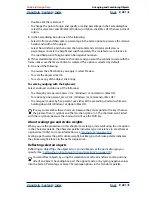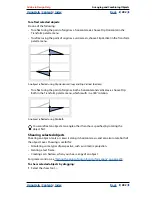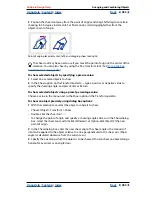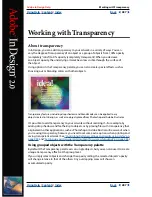
Using Help
|
Contents
|
Index
Back
272
Adobe InDesign Help
Arranging and Combining Objects
Using Help
|
Contents
|
Index
Back
272
Viewing geometric information in the Transform palette
When you select an object, its geometric information appears in the Transform palette. If
you selected multiple objects, the information represents all selected objects as a unit. All
transformations operate from the object’s origin; see
“Setting the point of origin for trans-
formations” on page 274
.
In addition, information about position is relative to the ruler origin. Angle information is
relative to the pasteboard, where a horizontal line has an angle of zero degrees. You can
change the way angle information is displayed for nested objects; see
“Setting the
reference orientation for nested objects” on page 272
.
To view geometric information about objects:
Select one or more objects, and display the Transform palette.
Setting the reference orientation for nested objects
The Transform palette orients an object to a spread’s pasteboard, where a horizontal line has
a rotation angle of zero degrees. By default, this is true even if the object is nested inside a
transformed
parent object
(that is, if the object is part of a transformed group or pasted
inside a transformed frame). For example, if you paste an unrotated graphic inside a frame,
rotate the frame ten degrees with the graphic inside, and then select the graphic using the
direct-selection tool, the Transform palette displays the graphic’s rotation angle as
ten degrees.
Object’s rotation angle displayed relative to pasteboard
If you prefer, you can deselect the Transformations are Totals command to see the same
information relative to the nested object’s parent. In the example above, if you deselect
Transformations are Totals, the Transform palette displays the graphic’s rotation angle as
zero (the angle it has relative to its rotated container).
Object’s rotation angle displayed relative to parent object
10
°
20
°






























